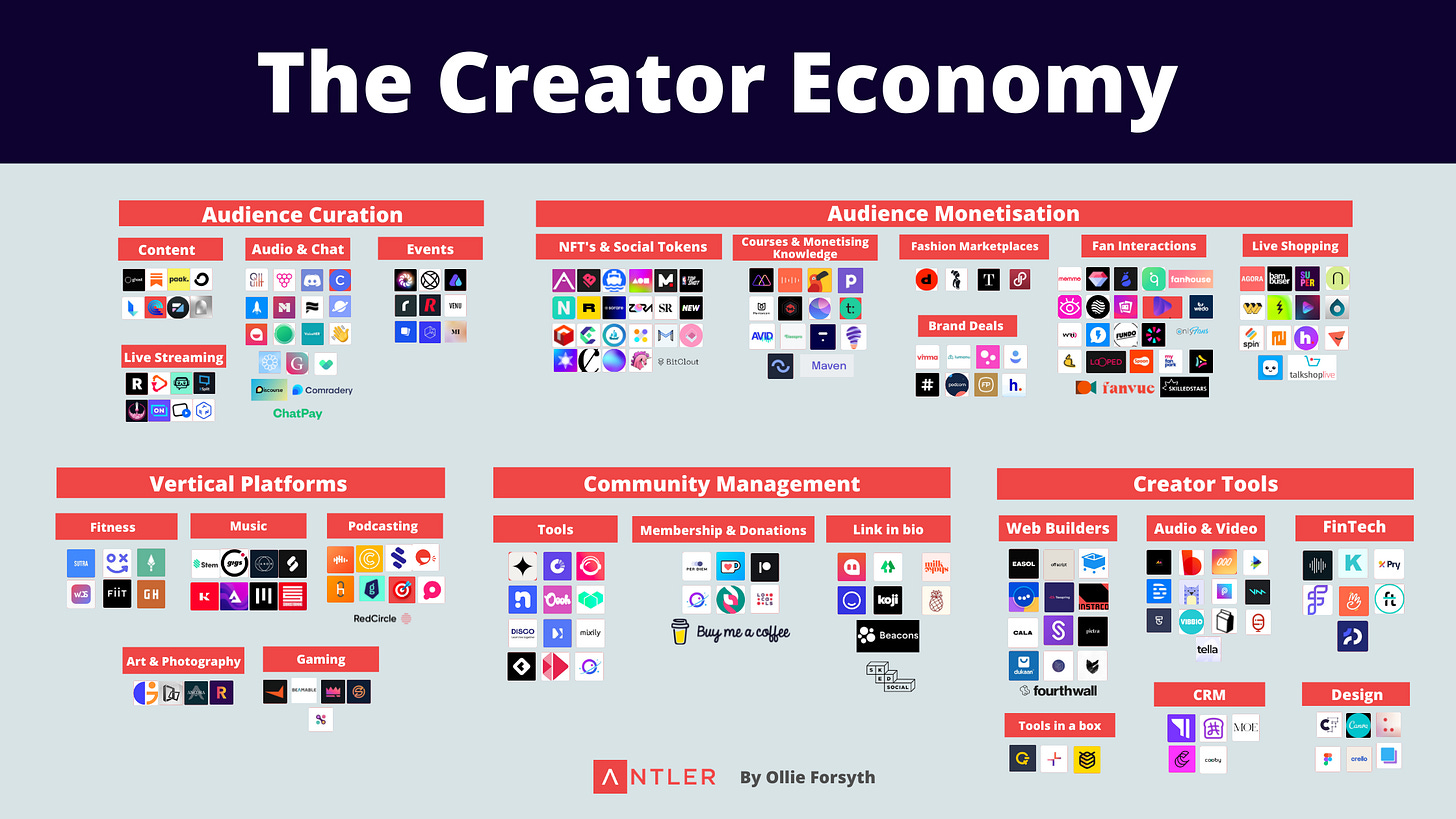The Ultimate Guide To The Creator Economy
220+ platforms that can help you turn your hobby into a paying profession!
The COVID pandemic has propelled the Creator Economy into a new era, fuelled by the upward trend of people monetizing their passions to make a living.
Last year, few European venture capitalists were focused on the Creator Economy space. Now, the majority of VCs we work with are pursuing deal flow in this booming sector.
This piqued interest in the Creator Economy coincides with a notable shift in GenZ’s career aspirations . As many as 29% of American students no longer want to become bankers, doctors or lawyers. Instead, they aspire to become creators. At current rates, this trend could see a generational shift in the global workforce.
Here’s why Gen Z will drive that change:
They want to have the flexibility to work and live anywhere in the world
They want full autonomy over their day to day agenda
They want to make an income by doing what they truly love
They want happiness and limited stress in their lives
To help you navigate this new economy and make the most of the new business born from it, we have mapped out the 220+ platforms that are empowering creators to make an income by doing what they love.
In mapping out the Creator Economy, we cover five main categories: audience curation, audience monetization, vertical platforms, community management, and creator tools.
We’ve also leveraged insights and opinions from dozens of industry leaders from founders, employees, creators, and investors from the likes of Shopify, Stripe, Greylock Partners, Northzone, Index Ventures, Atomico, Snapchat, TikTok, Slow Ventures, Mighty Networks, Product Hunt and Hustle Fund.
So, here you have it --
Audience Curation
What is it?
The platforms that are enabling creators to build foundational audiences. This allows creators to turn casual fans into super fans.
What are examples of some platforms?
Within this category, there are four main sub-sectors:
Audio & Community Chat - Platforms that allow creators to interact with their audience by chat or audio.
Examples: Bunches, ChatPay, Circle, Clubhouse, Community, Comradery, Disciple Media, Discord, Discourse, Guild, LaunchPass, MightyNetworks, Quilt, Quorum, Space, Tribe, Vibely, VoiceHER
Content & Newsletters - Platforms that allow creators to produce written content.
Examples: Compose.ai, Letterdrop, Flowrite, Mirror, Paak, Substack, Ghost, ConvertKit
Event platforms - Platforms that allow creators to host events.
Examples: Run The World, Rally, Moment House, Hopin,Airmeet, Icebreaker, Reach, Venu3d, Hubilo
Live streaming - Platforms that allow creators to go live to their audience.
Examples: OnJam, Pipeline, Restream, Stage Ten, Stream Elements, Streamlabs, Unscreen, XSplit, Wedo
According to a number of industry leaders in the space, the main challenge that exists within audience curation is the ability to empower creators to commercialize their content and unlock value.
Rex Woodbury, an investor at Index Ventures says, “Creating and earning income are often not aligned. We're seeing this change (particularly with a shift in business models away from advertising) but a creator's effort isn't always rewarded with monetary value. And because there's little infrastructure or social safety net built for this type of work, creators can face mental health challenges or burnout.”
Edwin Wee, Chief Millennial Officer at Stripe says, ‘’When somebody becomes a creator, they’re challenging the status quo. Many creators start as amateurs and there should be more platforms out there to help them become professionals and make a living out of content creation.’’
Eze Vidra, Managing Partner at Reimagine Ventures sums this up well: “Anyone can download a TikTok video or copy it, forward a newsletter or share ‘exclusive’ images with friends on Whatsapp. In music for example, the labels would go to great lengths to collect royalties for music in YouTube videos (how much of it actually goes to the artist is a different story), but creators have to fend for themselves.”
Simultaneously, there are some big opportunities at play within this space as we move into what Woodbury describes as “the decade of belonging”.
“People are tired of performing online and they want deeper, more intimate connections,” he says.
“As more people come online (there are now 4 billion internet users), what seem like niche communities can become surprisingly large. I'm interested in how creators can build and cultivate their own communities, and how content platforms can better enable the long tail of creators. We'll see more robust tools and infrastructure emerge for content and community management.”
Follow me on Substack and apply to Antler to build a defining company of tomorrow: www.antler.co.
The data of the companies provided in this piece will be updated on a quarterly basis. Subscribe to avoid missing the next big company!



Thank you for the exhaustive lists of startups and platforms to evaluate!
<Rant on>
The whole space is a joke: show me one platform that allows me (the creator) to sell an event ticket or membership, and do that legally correct, complying with GDPR, consumer protection, tax and accounting laws.
None of the "platforms" I evaluated can produce an invoice with correct VAT, depending on B2C/B2B status of the customer, their location, the product category, and attach some T&C, privacy policy and cancellation policy. They all get away with it when the monthly payments are $5-10, but for higher values (and we all are aiming for that, don't we?) the customer needs an invoice/receipt to get reimbursed or include in their tax return for deduction.
My money as investor is on Stripe. If they figure it out once and for all, then they deserve the extra margin. The so-called platform don't.
<rant off>
Tom